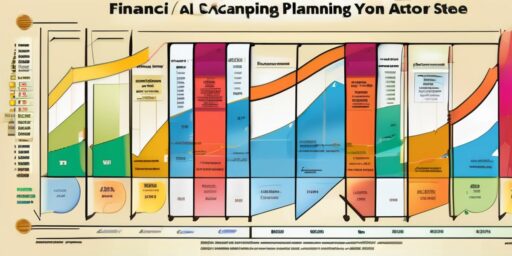Embarking on a journey to financial mastery is not just about accumulating wealth; it’s about unlocking the potential for a secure and prosperous future. ‘Maximizing Your Money: A Guide to Personal Finance Mastery’ is the ultimate guide to understanding the intricate dynamics of personal finance and developing strategies to achieve financial freedom. This guide draws inspiration from Tony Robbins’ ‘Money Master the Game’ and other financial experts to provide actionable insights and practical steps towards mastering your finances.
Key Takeaways
- Understanding your financial psychology and assessing your financial health are foundational steps towards setting achievable financial goals.
- Creating a personalized budget and implementing cost-saving techniques are crucial for effective money management and building a secure financial future.
- Investing intelligently requires knowledge of various investment vehicles, risk management, and a commitment to long-term strategies for wealth accumulation.
- Mastering debt and leveraging credit can significantly impact your financial well-being, making it essential to learn strategic debt repayment and credit card utilization.
- Planning for retirement and establishing an estate plan are key to ensuring financial security for yourself and creating generational wealth for your family.
Understanding the Foundations of Financial Freedom


The Psychology of Money Management
Understanding the psychology of money management is crucial for achieving financial freedom. Building financial resilience and overcoming limiting beliefs about money can lead to more informed and confident financial decisions. It’s important to recognize how emotions influence our financial choices and to find a balance between logic and emotions for better outcomes.
Gaining insight into your financial confidence and money mindset is a transformative process. It involves exploring the deep-seated beliefs that shape your financial attitudes, often rooted in early experiences.
To start this journey, awareness is the first step. Identifying your emotional responses to money, such as the fight or flight reaction, can reveal underlying patterns. From there, you can work on strategies to heal financial trauma and set actionable steps towards mindset mastery. Here’s a simple framework to begin with:
- Take the Money Mindset Personality Type Quiz to understand your financial tendencies.
- Use the Healthy Percentages Worksheet to allocate your income effectively.
- Set clear financial goals with the Financial Goal-Setting Worksheet.
- Learn and apply principles from the Money Mindset Mastery Course.
In essence, mastering the psychology of money is about replacing worry with a sense of wonder and curiosity about your financial potential. It’s a journey that starts with self-awareness and leads to strategic actions that align with your personal values and goals.
Assessing Your Financial Health
To truly master personal finance, one must first understand the main elements that go into financial health. This understanding is not just about knowing your current bank balance, but involves a comprehensive review of your financial resilience, beliefs, and behaviors.
- Assess your income and expenses to determine your net cash flow.
- Evaluate your savings and investment accounts for future security.
- Review your debt obligations and credit status to identify areas for improvement.
Building financial confidence is a journey that starts with awareness and a clear assessment of where you stand financially.
By taking a holistic approach, you can find the sweet spot between logic and emotions, leading to better financial decision-making. Utilize tools like the Healthy Percentages Worksheet or the Financial Goal-Setting Worksheet to kickstart your journey towards financial clarity.
Setting Realistic Financial Goals
Setting realistic financial goals is a pivotal step in achieving financial freedom. Clarifying your financial aspirations is crucial; it’s about knowing what you want to achieve and by when. Whether it’s financial security, vitality, independence, or absolute freedom, having a clear vision of your desired level of financial abundance is essential.
To set effective financial goals, start by creating and sticking to a budget. It’s the foundation that supports all other financial planning efforts.
Here are six steps to guide you through the process of setting your financial goals:
- Commit to financial mastery by deciding to take control of your finances.
- Define your financial goals and what they mean to you.
- Create a budget plan that aligns with your goals.
- Implement strategies to increase income and minimize expenses.
- Maximize investment returns to accelerate progress.
- Envision your journey towards achieving these goals and make informed decisions.
Remember, aligning your personal values with your financial strategies is key to growth and success. By following these steps, you can create a roadmap that leads to long-term financial security and the creation of generational wealth.
Strategies for Effective Budgeting and Saving


Creating a Personalized Budget Plan
Creating a personalized budget plan is the cornerstone of sound financial management. Developing a budget that reflects your income, expenses, and financial goals is essential for gaining control over your money. Start by reviewing your account statements to get a clear picture of where your money is going. Categorize your expenses to identify areas where you can cut back. Consistency is key; ensure you track your expenses regularly to maintain an accurate budget.
A well-crafted budget is not just a spending plan, it’s a tool that guides your financial decisions and helps you prioritize your goals.
Remember, a budget should be flexible. Life is unpredictable, and your budget should adapt to changes in your financial situation. Explore other options and tools that can help you stay on track, such as budgeting apps or financial advisors. By taking these steps, you’ll be well on your way to mastering your personal finances.
Techniques for Reducing Expenses
In the quest for financial stability, reducing expenses is as crucial as increasing income. By examining and adjusting your spending habits, you can free up funds for saving and investing. Here are some practical techniques to help you cut costs:
- Keep Track of Your Spending Habits: Awareness is the first step towards change. Use a ledger or an app to monitor every dollar spent.
- Create a Budget: Establish clear financial boundaries and stick to them.
- Update Subscriptions: Regularly review and cancel unnecessary subscriptions.
- Save on Utility Costs: Implement energy-saving measures at home.
- Cheaper Housing Options: Consider downsizing or relocating to a more affordable living space.
- Consolidate Debts: Combine multiple debts into a single payment to reduce interest rates and monthly payments.
By implementing these strategies, you not only trim your expenses but also pave the way for a more secure financial future.
Remember, the power of expense tracking cannot be overstated. It’s the first domino to topple in a chain of fiscal wins, leading to strategic cuts and more room for investments and savings.
Smart Saving Habits for Future Security
Developing smart saving habits is crucial for securing your financial future. Regularly monitoring your spending is a transformative habit that can lead to significant savings over time. By keeping track of where every dollar goes, you can identify areas where you can cut back and redirect funds towards your savings goals.
Establishing an emergency fund is a foundational step in building financial security. Aim to save at least three to six months’ worth of living expenses to protect yourself from unforeseen circumstances.
Here are some practical tips to enhance your saving habits:
- Prioritize your savings by setting up automatic transfers to your savings account.
- Review and adjust your budget regularly to align with your financial goals.
- Avoid impulse purchases by waiting 24 hours before making a significant buy.
- Utilize cashback and rewards programs to earn money on purchases you would make anyway.
Remember, the path to future security is paved with consistent and mindful saving practices. Start small, stay disciplined, and watch your nest egg grow.
Investing Wisely: Building Your Financial Portfolio


Introduction to Investment Vehicles
Before diving into the specifics of various investment options, let’s start by defining what an investment vehicle is. An investment vehicle is any instrument that allows you to put your money into assets with the potential for growth, income, or both. Common types of investment vehicles include stocks, bonds, mutual funds, exchange-traded funds (ETFs), and more recently, cryptocurrencies.
Investment vehicles are the tools through which individuals can channel their funds into the market with the aim of generating returns.
Understanding the different characteristics of each vehicle is crucial for making informed decisions. Here’s a brief overview:
- Stocks: Ownership shares in a company, with potential for capital gains and dividends.
- Bonds: Debt securities issued by entities, offering regular interest payments and return of principal at maturity.
- Mutual Funds: Pooled investments managed by professionals, providing diversification across multiple assets.
- ETFs: Similar to mutual funds but traded like stocks, offering flexibility and often lower fees.
- Cryptocurrencies: Digital or virtual currencies that use cryptography for security, a high-risk but potentially high-reward option.
Each investment vehicle comes with its own set of risks and rewards, and the right choice depends on your financial goals, risk tolerance, and investment horizon.
Risk Management and Diversification
Achieving a balanced investment portfolio is essential for mitigating risk and enhancing the potential for returns. Diversification across various asset classes is the cornerstone of risk management in investing. By spreading investments across stocks, bonds, real estate, and other vehicles, you can protect your portfolio from the volatility of any single asset.
Diversification is not just about having different assets; it’s about having assets that react differently to the same economic events. This means that when one asset class is underperforming, another may be thriving, thus balancing out the performance of your portfolio.
Here’s a simple breakdown of asset classes and their characteristics:
- Stocks: Potential for high returns; higher risk
- Bonds: Lower risk; steady income
- Real Estate: Tangible asset; potential for appreciation and rental income
- Commodities: Includes precious metals; can hedge against inflation
- Cash Equivalents: Low risk; provides liquidity
Remember, the key to diversification is not just quantity but the quality of assets and how they complement each other in your investment strategy.
Long-Term Investment Strategies
Adopting long-term investment strategies is essential for achieving financial stability and growth. Diversification is the key to reducing risk while maximizing potential returns over time. It’s not just about picking stocks, but about creating a balanced portfolio that can withstand market fluctuations.
When considering long-term investments, it’s important to look at a variety of asset classes. Here’s a list of the 5 best long-term investments to add to your portfolio in 2023:
- Exchange Traded Funds (ETFs)
- Dividend Stocks
- Short-term Bonds
- Real Estate
- Alternative Assets
Each of these options has its own set of benefits and risks, and should be chosen based on your individual financial goals and risk tolerance. For instance, ETFs offer a way to invest in a diversified portfolio of stocks or bonds, while real estate can provide both rental income and property value appreciation.
Asset allocation is a cornerstone of successful investing. Allocating your resources wisely across different asset classes can significantly impact your long-term financial prosperity.
Remember, the journey to financial mastery is not a sprint but a marathon. Patience, consistent investing, and staying informed are crucial to navigating the complexities of the financial markets and securing your financial future.
Mastering Debt and Credit Management


Understanding Credit and Its Impact
Credit is an integral part of financial stability and growth. Your credit score is a reflection on your financial history and current circumstances. It is a critical factor that lenders consider when you apply for loans, mortgages, or credit cards. A higher score can lead to better interest rates and terms, while a lower score can significantly limit your financial options.
- Learn how credit cards work
- Explore different types of credit cards and their benefits
- Understand how to build credit and avoid common pitfalls
Credit not only affects your ability to borrow but also influences areas you might not expect, such as rental agreements, insurance premiums, and even employment opportunities. It’s essential to grasp the full scope of its impact to navigate the financial world with confidence.
Using credit cards wisely is a skill that involves managing balances, paying bills on time, and understanding how reward programs operate. It’s about making credit cards work for you, not against you. By mastering your credit score and the responsible use of credit, you can pave the way for a secure financial future.
Strategies for Paying Off Debt
Successfully managing and paying off debt is a critical step towards financial freedom. One effective strategy is to prioritize debts by interest rate, often referred to as the ‘avalanche method.’ This approach involves making minimum payments on all debts, while allocating extra funds to the debt with the highest interest rate first.
Another strategy is the ‘snowball method,’ where you focus on paying off the smallest debts first to gain momentum. As each debt is paid off, the money used for that debt is then rolled into the next smallest balance.
It’s essential to create a plan that aligns with your financial situation and goals. Adjusting your budget to find extra money for debt repayment can accelerate the process. Consider boosting your income with a side hustle and applying any additional earnings towards your debt.
Lastly, consider consulting with a financial advisor to tailor a debt repayment plan that’s right for you. They can provide insights on debt consolidation options and negotiate with creditors on your behalf.
Using Credit Cards to Your Advantage
Credit cards, when used wisely, can be a powerful tool in managing your finances and building your credit history. Understanding how to leverage them effectively is key to maximizing their benefits. It’s crucial to learn the different types of credit cards and their respective rewards programs to ensure you’re getting the best return on your spending.
- Learn how credit cards work
- Explore different types of credit cards and their benefits
- Understand how to build credit and avoid common pitfalls
The best way to avoid credit card debt is to pay your balance in full each month. To achieve this, it’s essential to spend within your means and manage your balances carefully.
Additionally, being aware of how your credit score is calculated and the factors that influence it can help you use credit cards to your advantage. Regular, responsible use of credit cards can contribute to a healthy credit score, which can open doors to better loan conditions and interest rates in the future.
Planning for the Future: Retirement and Estate Planning


Retirement Savings Plans and Options
Choosing the right retirement plan is crucial for ensuring a comfortable and secure future. Different retirement accounts offer varying benefits, and it’s important to select one that aligns with your financial situation and goals. For instance, a 401(k) plan is often provided by employers and can include matching contributions, while Individual Retirement Accounts (IRAs) offer more control and investment options.
When considering retirement plans, it’s essential to understand the differences between traditional and Roth options. Traditional plans typically provide tax deductions on contributions, with taxes deferred until withdrawal. Roth plans, on the other hand, are funded with after-tax dollars, allowing for tax-free withdrawals in retirement.
For the self-employed and business owners, options like SEP IRAs and Solo 401(k)s provide flexible contribution limits and tax advantages. It’s important to weigh the pros and cons of each plan to determine the best fit for your retirement strategy.
By starting early and making informed decisions about your retirement savings, you can take advantage of compound interest and build a substantial nest egg over time.
Estate Planning Essentials
Estate planning is a crucial step in ensuring that your assets are distributed according to your wishes after you pass away. Proper estate planning can also significantly reduce the tax burden on your heirs, ensuring that your legacy is preserved and passed on efficiently.
When considering estate planning, it’s important to understand the various tools at your disposal:
- Wills: The basic document for stating your wishes
- Trusts: Can help avoid probate and provide more control over asset distribution
- Power of Attorney: Authorizes someone to make decisions on your behalf
- Healthcare Directives: Specifies your wishes for medical care if you’re unable to communicate
Remember, estate planning is not just for the wealthy; it’s a vital process for anyone who wants to have a say in how their assets are handled after their death. It’s also a living document that should be reviewed and updated regularly to reflect changes in your life circumstances.
To ensure that your estate plan is solid, work with a qualified attorney who specializes in this area. They can help you navigate complex laws and regulations, and tailor a plan that fits your unique situation.
Creating a Legacy of Generational Wealth
Creating a legacy of generational wealth is not just about amassing a fortune; it’s about establishing a foundation that will support your family for generations to come. Building generational wealth requires a strategic approach that encompasses not only financial assets but also the transmission of values, knowledge, and a mindset geared towards prosperity.
To embark on this journey, consider the following steps:
- Talk about money openly with your family to foster financial literacy.
- Invest for the future, prioritizing assets that offer long-term growth.
- Use debt responsibly, leveraging it to create opportunities rather than burdens.
- Have a comprehensive estate plan to ensure your wealth is distributed according to your wishes.
- Consider life insurance as a tool to protect your legacy.
By adhering to these principles and taking proactive steps, you can pave the way for a future where your descendants are not just beneficiaries of your wealth, but active stewards of a flourishing financial legacy.
Remember, the goal is to create a roadmap that not only leads to financial freedom but also empowers future generations to build upon and expand the wealth you’ve established. The principles of Kingdom Finance, for instance, can be a guiding light in aligning your financial actions with a greater purpose, thereby advancing the well-being of your family, community, and the world at large.
Conclusion
As we wrap up this ultimate guide to personal finance mastery, it’s clear that the journey to financial freedom is both an art and a science. From the actionable strategies in Tony Robbins’ "Money Master the Game" to the comprehensive training offered by "The Financial Mastery Academy," the resources available to us are abundant and insightful. By embracing the seven simple steps to financial freedom, meticulously planning our budgets, and making informed investment decisions, we can unlock our financial potential and pave the way for generational wealth. Whether you’re a young adult mastering credit cards or a seasoned investor expanding your portfolio, the principles of financial mastery remain the same. It’s time to empower ourselves, take control of our financial destinies, and turn the dream of prosperity into a tangible reality. Remember, the path to financial success is within reach—start your journey today and unlock the wealth that awaits.
Frequently Asked Questions
What are the first steps to achieving financial freedom?
The first steps include understanding the psychology of money management, assessing your current financial health, and setting realistic financial goals that align with your long-term objectives.
How do I create a budget that works for my lifestyle?
To create an effective budget, start by tracking your income and expenses, categorize your spending, and set limits for each category based on your priorities and financial goals.
What investment vehicles should I consider as a beginner?
Beginners can consider starting with low-risk investment vehicles such as savings accounts, certificates of deposit (CDs), or index funds, and gradually move to more diverse options as they gain confidence and knowledge.
How can I use credit cards to improve my financial situation?
Use credit cards responsibly by paying off balances in full each month, taking advantage of rewards programs, and using them to build a positive credit history.
What are some strategies for paying off debt effectively?
Strategies for paying off debt include the snowball method (paying off smaller debts first), the avalanche method (targeting debts with the highest interest rates), and consolidating debts to secure lower interest rates.
Why is estate planning important and how do I get started?
Estate planning is crucial for ensuring your assets are distributed according to your wishes after your passing. To get started, create a will, consider setting up trusts, and designate beneficiaries for your accounts and policies.





